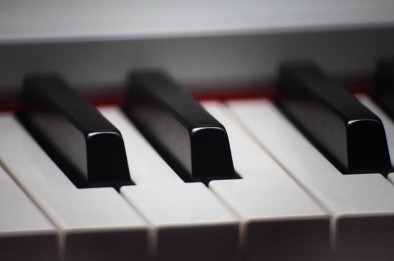
Your average piano player will be quite familiar with basic chords. You know... Major, minor, suspended etc. In fact, you’ll find basic chords (and sometimes their chord symbols) in most popular sheet music for simple pop or folk songs.
But what about more advanced chords that we hear in our favorite music? I‘ve had people tell me that they can play some of the same songs they hear elsewhere, but their version is so bland. The chords they play have no flavor.
The most apparent reason for this is that they are playing basic chords when it’s the more advanced chords that give a song its flavor.
So what exactly are advanced chords?
Without getting into and breaking down advanced chords in detail, I’ll just define them as extended or altered chords that can give a plain Major or minor chord a more colorful sound.
Comparative Examples
Major chords are as simple as it gets.
C Major Chord
F Major Chord
G Major Chord
Adding tones to them to create extended chords give you an entirely new sound.


Suspended chords fall into the category of simple chords, but when you add extended tones to them, they too give you an entirely new sound.
A C sus4 chord turns into a C11 chord when you add the dominant 7th (B flat)

This article is about slash chords and how you can use them to create more advanced chords. It’s about simplifying the process instead of building those advanced chords from the ground up.
Introducing the Slash
Regular chords emphasize the root of the chord in the bass.
C Major will have a C in the bass. G Major will have a G in the bass.
G Major will have a G in the bass.
Etc.
Having the root note in the bass establishes the foundation of the chord. It solidifies the chord as being a part of the diatonic structure of the key it’s being played in. Diatonic simply means within the key and the root of any particular chord can represent any one of the 7 different notes in that key.
What does a slash do?
A slash indicates that you play a note that is not the root of the chord. It’s an alternate bass note that can cause the chord to have a different character while still remaining the same chord. It can also redefine the chord as to create a totally different chord.
Different Note, Same Chord
If you’re playing a chord that could really benefit from a different sound without altering it entirely, you can play one of the tones within the chord itself in the bass. One very common slash chord is to have a chord over its 3rd.
The C Major chord over E is still a C Major chord but definitely has a different sound without the root in the bass. You wouldn’t make this choice if your desire was to play the chord with a sound of resolution or ending shall I say. But it is a refreshing chord change.
Here are some other examples of a Major chord over its 3rd.


The 5th of the chord can also be played in the bass without changing the chord. This would be a Major triad over its 5th.
other examples of a Major chord over its 5th.

 You’re not limited to playing simple triads with the 3rd in the bass. Check out the sounds of playing 7th chords with the 3rd in the bass.
You’re not limited to playing simple triads with the 3rd in the bass. Check out the sounds of playing 7th chords with the 3rd in the bass.


Chords Redefined
The magic of slash chords is that they allow you to change the bass note and redefine the chord in a way that makes it simple to execute. This means using less brain power to play more advanced chords.
You can do this by adding any of the tones that exist in the key of music that the root chord is derived from.
The 7 notes of the key of C Major
Among the most common slash chords is playing a simple Major triad with a 6th in the bass. This redefines the chord as minor 7 chord.


You can also play the 2nd tone in the bass which redefines the chord as an 11th chord based on (or named after) the 2nd tone itself.

 You can also play the 4th tone in the bass which redefines the chord as a Major 7 sus 2. This chord will be based on (or named after) the 4th tone. The reason for it being so named is that there isn’t a Major or minor 3rd in the chord so it isn’t Major or minor. The 2nd can serve as a suspended tone because it has a suspended quality to it. You could also refer to this chord as a Major 9 with no 3rd and it would still be a correct way to refer to the chord.
You can also play the 4th tone in the bass which redefines the chord as a Major 7 sus 2. This chord will be based on (or named after) the 4th tone. The reason for it being so named is that there isn’t a Major or minor 3rd in the chord so it isn’t Major or minor. The 2nd can serve as a suspended tone because it has a suspended quality to it. You could also refer to this chord as a Major 9 with no 3rd and it would still be a correct way to refer to the chord.


The examples I’ve shown you here are just in a handful of keys. You have all 12 Major keys at your disposal. In addition to that, we’ve only covered the tones that are within the key of the root chord itself. So you can definitely go further with slash chords by adding chromatic tones (notes that aren’t in the key of the root chord).
Slash chords can be used as substitute chords or passing chords when time and space allows for them in a song. Have fun experimenting and using slash chords in your music. It’s a sure concept to sound like a professional at your piano the easy way.
Until next time, Go Play!
Greg Lee
Latest posts by Greg Lee (see all)
- What is a minor/Major 7 Chord? - October 26, 2023
- 7 Chord Substitutions that Professionals Use - October 19, 2023
- 5 Simple Chord Tricks to Sound Amazing - October 5, 2023



